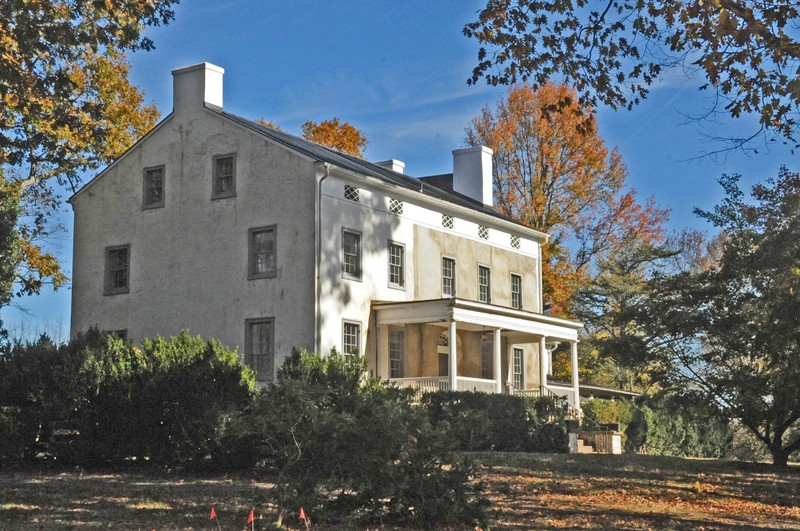Oakham Farm
Introduction
Text-to-speech Audio
Images
Oakham Farm

Backstory and Context
Text-to-speech Audio
The land that is now Oakham Farm was purchased by Colonel Francis Peyton in the mid-to-late 1700s. Peyton was a prominent citizen in Loudoun County, serving as one of the first County Justices and Under-Sheriffs and as a member of the House of Burgesses and a soldier in the Continental Army during the Revolutionary War. He gave 450 acres to his son, Townsend Dade Peyton, in 1799. One of the Peytons, either Francis, during the earlier 1790s, or Townsend, immediately after receiving the land, built a home on the property, as well as another two-story structure, possibly a small dwelling or kitchen. Townsend received the rest of Francis’s land and property, including his mill and several slaves, upon his death in 1815. Townsend was a successful and wealthy farmer and miller; however, he sold all of his Virginia properties by 1835 and moved to Ohio. Hamilton Rogers bought 519 acres—what he later called Oakham Farm—from Townsend in 1835 and moved his wife and family there.
In 1840, Rogers added onto the small building constructed by the Peytons. He also eventually converted the home they built into a schoolhouse, with a second-story teacher’s quarters, for the education of his nine children. In 1847, he built a three-story, three-bay stucco-over-stone home connected to the west side of the small structure built by the Peytons in the late 1700s—making this building the east wing of the new mansion. The home was designed in the Greek Revival style and features intricate mantels, molding, and ceiling medallions throughout. (He also built a meat house and smokehouse, which remain on the grounds today, in the same year.) The home reflected Rogers’s wealth: he possessed a total of 891 acres, his farms were incredibly prosperous, and he owned as many as 25 slaves. He was also an officer in the Virginia Militia, a Magistrate, a County Court Judge, and the Chairman of the Commonwealth Court.
Rogers served as a Colonel in the Confederate Army during the Civil War. He also opened his home to men like General J.E.B. Stuart, who used it as a headquarters. Stuart stopped there during his Christmas Raid of 1862, while on his way back to Confederate lines after leaving Fairfax Courthouse and the Frying Pan area of Fairfax County. It was most likely while there that Colonel John S. Mosby asked Stuart for permission to stay behind with a small band of raiders to harass Union forces. Stuart approved, and this group eventually morphed into the 43rd Battalion, 1st Virginia Cavalry, better known as “Mosby’s Rangers”. The Rangers’ groundbreaking guerilla-warfare tactics were incredibly effective and gained them legendary status as one of the most famous units of the war. A few years later, over a five-day period in November and December 1864, most of Rogers’s farm was destroyed during Union General Philip Sheridan’s “Burning Raid” in Loudoun and Fauquier Counties.
After the war, Hamilton Rogers and his family found themselves in severe financial trouble due to the collapse of the southern economy. While he was ultimately able to keep Oakham Farm by selling it to his son, William, he lost all of his other property. Hamilton died at Oakham in 1882. William farmed the land for two more decades after his father’s passing, during which time he built a stucco barn that still stands on the property. He sold the estate in 1902 to Rosamind Toulmin; she and her husband were northerners and most likely looking for a country estate for horseracing and fox hunting. Oakham Farm passed to two other owners before it was purchased by Eugenia Fairfax in 1927. She was the widow of Henry Fairfax, who was, in fact, the grandson of Hamilton Rogers—his parents, John Walter and Mary Jane (Rogers) Fairfax, had been married in the Oakham mansion’s front parlor.
Eugenia Fairfax commenced a major renovation under a prominent architectural firm, Baskervill & Lambert (now known simply as Baskervill) of Richmond. On top of modernizing and restoring the original sections of the home, they added a three-story, two-bay extension to the west end of the mansion, moved the porches to create a central entrance, and altered the floor plan. While they largely matched the new and old sections of the house, the additions and renovations were still noticeably done in the Classical Revival style prevalent at the time.
Around 1940, Eugenia built a new chicken coop, garage, chauffeur’s quarters, and inground pool on the property, all of which survive today. The estate passed to her grandsons, Edwin and Henry Conquest, upon her death in 1966; they never lived there, and began selling their property in 2006. The Oakham mansion and a surrounding 100-acre tract were placed under a conservation easement for protection and, in 2016, added to the Virginia Landmarks Register and the National Register of Historic Places. By 2012, the estate was listed for sale for $3.5 million. Three years later, it was transferred to the Oakham Farm Venture, Inc., which intended to use the property for agriculture once again.
Sources
23226 Oakham Farm Ln, Washington Fine Properties. Accessed June 26th 2020. http://spws.homevisit.com/hvid/26916.
Covington, Jane. Kimball, Lori. Oakham Farm, National Register of Historic Places Registration Form, Virginia Department of Historic Resources. December 10th 2016. Accessed June 26th 2020. https://www.dhr.virginia.gov/VLR_to_transfer/PDFNoms/053-0091_OakhamFarm_2015_NRHP_FINAL.pdf.
Orrison, Rob. “…please furnish better mules…”— JEB Stuart’s 1862 Christmas Raid, Part Two, Emerging Civil War. December 30th 2014. Accessed June 26th 2020. http://emergingcivilwar.com/2014/12/30/please-furnish-better-mules-jeb-stuarts-1862-christmas-raid-part-2/.
By Jerrye and Roy Klotz MD on Wikimedia Commons (https://commons.wikimedia.org/wiki/File:OAKHAM_FARM,_MIDDLEBURG,_LOUDOUN_COUNTY._VA.jpg) - CC BY-SA 4.0 (https://creativecommons.org/licenses/by-sa/4.0)
